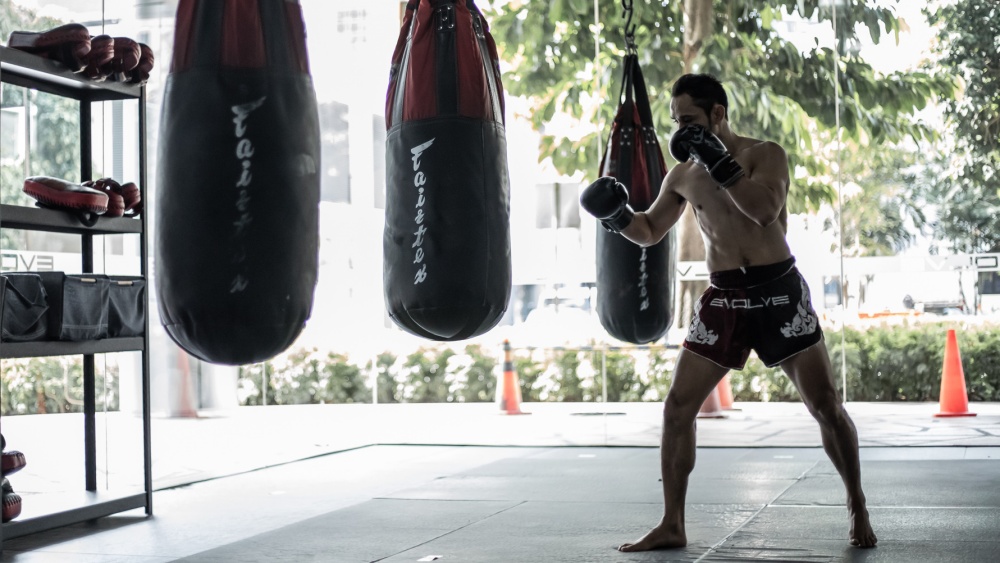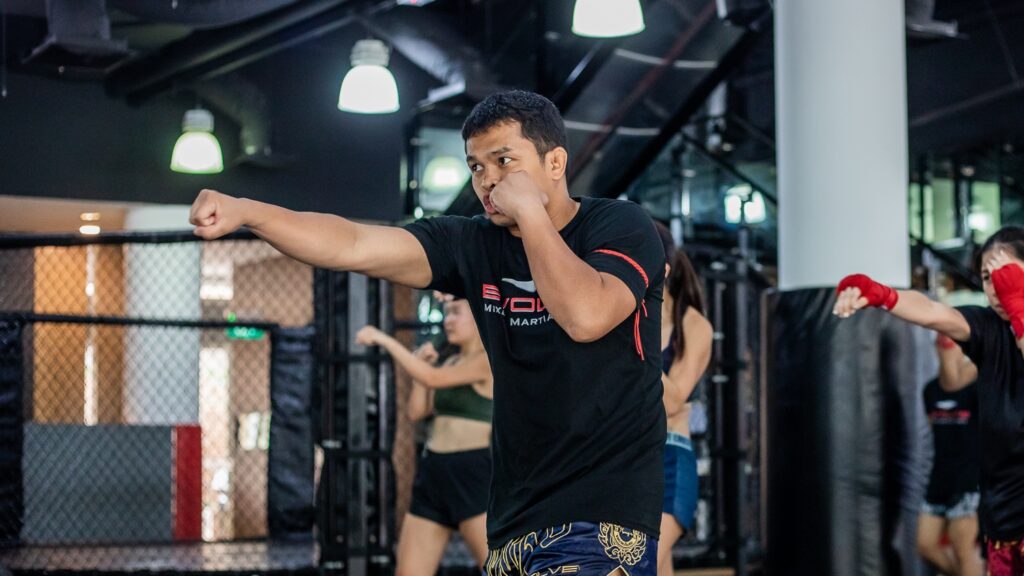Muay Thai may be the Art of Eight Limbs, but you can’t use any of them effectively without good Muay Thai footwork.
Movement is arguably the most important part of the sport. Your attacks won’t be successful if you’re not in the right place to use them, and a vital part of defense is getting out of the way.
That’s why beginners need to nail the fundamentals of Muay Thai footwork early in their training.
Use these basic drills you can do on your own, and you’ll build the foundations for good Muay Thai footwork to start gliding around the ring in no time.
Note – All instructions are for orthodox fighters. If you’re a southpaw, just use the opposite side.
Drill #1 – Moving In A Straight Line
Before you do anything else, you need to know how to go forward, back, left, and right in order to establish good Muay Thai footwork.
It’s key to move in rhythm, and in a way that allows you to maintain your base. That means you’ll be stable and balanced so you can strike, defend, and change direction without making a big adjustment.
Before you even take a step, make sure you’re set in your stance, your knees are slightly bent, and your weight is central as you move on the balls of your feet.
- Move forward by stepping with your left foot first. When it touches the mat, move your right foot the same distance. Your feet should be the same distance apart as when you started.
- Move back by stepping with your rear foot first, then bring your left foot behind it.
- Move right by moving your right foot first. Again, your left foot should follow.
- Move left in the same way – this time, it’s left foot first, and the right will follow.
That’s all there is to this drill. Take a few steps one way and then another, and repeat – over and over again.
Admittedly, this is not a fun drill. However, if you devote time to practicing this, it will be the perfect foundation for your entire Muay Thai skillset.
Work With A Partner: There are two ways to bring an additional element to this drill.
First, you can get a training partner to call out directions. If you don’t know what’s coming, you’ll have to react and adjust on the fly. This will really test if you are shifting your weight too much to change direction quickly.
The second way is to mirror a partner’s movement. Stand opposite them and follow their lead. If they step back, you go forward. If they move left, go right to stay in front of them.
Drill #2: Cut An Angle
Now for a way to move into an attacking position.
By moving off the centerline, you’ll be able to create angles and come at your opponent in a way that will make them much more vulnerable.
To move off to the left:
- Step forward and out at a 45-degree angle with your left foot.
- Pivot on your front foot and turn to the right by moving your right foot behind you in a clockwise direction.
- Land with your right foot back in an orthodox stance.
To move off to the right:
- Step forward and out with your right foot. This step should be slightly further than when you step to your left, but don’t go too far and lose balance.
- Pivot on your right foot and turn to your left by moving your left leg anticlockwise.
- Land with your left foot back, in a southpaw stance.
Work With A Partner: This is a great technique to use against an aggressive opponent that comes forward a lot. Have your teammate walk forward so you can slip around them and emerge to the side of them.
Drill #3: Circle Away
Time to switch things up to do some defensive work.
If you don’t fight fire with fire against an aggressive opponent, your best bet is to move away so you can reset and set up a new plan of attack.
You can step back, but it’s best to avoid moving back in a straight line because you’ll soon run out of ring and end up in a bad position, against the ropes.
There are two ways to circle away, and it may depend on your opponent
- To circle to your left, take a step straight back, first.
- Once you have created some distance, start stepping to your left along a circular track.
It’s difficult to move diagonally back to your left without crossing your legs or compromising your Muay Thai defense, so it’s best to create that space, and then move away.
This is best against a southpaw. You almost always want to move away from your rival’s power. That’s the left side of an orthodox fighter, so move to their right.
Against an orthodox opponent, you’ll want to move away from their right side, so that’s to your right.
You can still step straight back, but you can also move backward and laterally at the same time.
- Start to move back and to the right by stepping diagonally back, right foot first.
- Continue to move laterally, around where your opponent would be.
Work With A Partner: Similar to cutting an angle, this works best against an aggressive opponent. Get your teammate to come at you, and force them to follow you as you circle around 180 degrees to face where you started.
Drill #4 – Heavy Bag

Now you can use what you’ve learned on the heavy bag.
- Stay on the balls of your feet as you step toward the bag, away from it, and laterally around it.
- Lead with the outside leg as you move laterally, your front leg when you move forward, and your back leg when you move back.
- Maintain your balance as your shift your weight and don’t cross your feet.
- Once you’re comfortable moving your feet smoothly, you can start to strike the bag.
- Try to cut some angles on the bag and circle around it – particularly when it swings toward you.
You may also like:

















